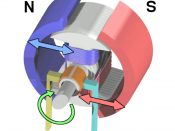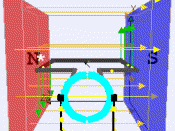What is a motor made out of and how it works?
A simple motor has six parts:
Armature or rotor
In an electric motor the moving part is the rotor which turns the shaft to deliver the mechanical power. The rotor usually has conductors laid into it which carry currents that interact with the magnetic field of the stator to generate the forces that turn the shaft. However, some rotors carry permanent magnets, and the stator holds the conductors
Commentator
A commentator is a mechanism used to switch the input of certain AC and DC machines consisting of slip ring segments insulated from each other and from the electric motor's shaft. The motor's armature current is supplied through the stationary brushes in contact with the revolving commentator, which causes required current reversal and applies power to the machine in an optimal manner as the rotor rotates from pole to pole.
In absence of such current reversal, the motor would brake to a stop. In light of significant advances in the past few decades due to improved technologies in electronic controller, sensorless control, induction motor, and permanent magnet motor fields, electromechanically commutated motors are increasingly being displaced by externally commutated induction and permanent magnet motors.
Brushes
All self-commutated DC motors are by definition run on DC electric power. Most DC motors are small PM types. They contain a brushed internal mechanical commutation to reverse motor windings' current in synchronism with rotation
Field magnet and windings
Windings are wires that are laid in coils, usually wrapped around a laminated soft iron magnetic core so as to form magnetic poles when energised with current.
Electric machines come in two basic magnet field pole configurations: salient-pole machine and nonsalient-pole machine. In the salient-pole machine the pole's magnetic field is produced by a winding wound...


